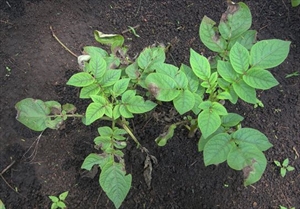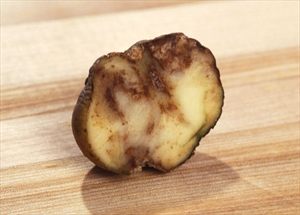Potato late blight
Pacific Pests, Pathogens, Weeds & Pesticides - Online edition
Pacific Pests, Pathogens, Weeds & Pesticides
Potato late blight (265)
Phytophthora infestans
Asia, North, South and Central America, the Caribbean, Europe, Oceania. It is recorded on potato from Australia, American Samoa, Fiji, New Caledonia, New Zealand, and Papua New Guinea. It is recorded on 'Solanaceae' from American Samoa.
Potato, tomato (see Fact Sheet no. 261), and wild species in the potato (Solanum) family, e.g., nightshade (Solanum nigrum). There is evidence of strains attacking either potato or tomato, and there may be species that are specific to other hosts.
Phytophthora infestans is not a fungus, but an oomycete or a water mould, related to algae. The life cycle, however, has many fungal-like characteristics.
Symptoms on potato and tomato are similar. Brown irregular-shaped spots occur on the leaves spreading from the tips and margins and expanding rapidly. The spots are not limited by the leaf veins. Within a few days the leaves turn yellow, shrivel and die (Photo 1). Black or brown spots occur on the stems. Spores, formed in the white cottony growth at the edge of the spots on leaves (Photo 2) and stems, wash into the soil and infect the tubers through cracks, 'eyes' (buds) and lenticels, and cause brownish-reddish rots (Photo 3); the tubers become soft and smelly as bacteria invade and destroy them. Rots can also form later in apparently healthy tubers in storage. Plants are destroyed a few days after the first spots appear.
Late blight has two ways of reproducing; (i) spores called 'sporangia' are produced without going through a sexual process or (ii) spores called 'oospores' are produced when two strains (A1 and A2) come together and mate.
The sporangia on the leaves, stems and tubers within the cottony growth are spread by wind, rain and water splash. If the sporangia land on a potato plant, and the surface is wet, they germinate. There are two ways of doing this depending on temperature: (i) in warmer conditions (21-26°C), the spores germinate like seeds and infect the plant directly, or (ii) in cooler conditions (18-22°C) each spore produces 6-8 smaller spores (called 'zoospores') which burst out of the larger spore and swim short distances over the plant surface before germinating and infecting. Sporangia and zoospores survive only for a few days in plant remains or in the soil.
By contrast, oospores are resting spores; they have thick walls for survival either in plant remains, in the soil or in the tubers. Oospores germinate and produce sporangia.
Epidemics of late blight occur when night temperatures are cool, followed by warm days with mists and rains. Under those conditions, sporangia and zoospores spread the disease rapidly and fields of potato are destroyed in a less than 2 weeks.
Spread of late blight over short to moderate distances between plants and fields occurs as sporangia and zoospores in wind or wind-driven rain. Sporangia can travel as far as 15-20 km. Spread over longer distances, across countries and continents, occurs in tubers used as 'seed' for planting.
Survival of late blight between crops occurs as oospores, where A1 and A2 strains occur together, but this is not as important as survival in tubers. Spores are produced on the surface of tubers in the cull piles (reject tubers), and on volunteer plants from tubers left in the ground. See life cycle (Diagram).
Late blight is one of the world's worst plant diseases, despite efforts to control it for more than 150 years. It causes large losses in yields of potatoes and tomatoes, and requires the application of expensive fungicides to maintain control. Until the 1980s, the A2 strain was known only in Mexico. Since then it has spread to many countries, and where mating with the A1 strain occurs the offspring are more aggressive, produce more spores and have increased tolerance to fungicides.
CIP (the International Potato Center, Peru) estimates that about 15% of the annual production of developing countries is lost to potato late blight each year. The cost is estimated at about US$3 billion.
Look for spots and patches on the leaves which grow rapidly and produce a furry white growth on the underside. Look for the white growth after putting the leaves in a plastic bag overnight. Check the plants regularly for infections, especially when the days are cool and wet, or overcast with heavy dews, fogs or mists.
QUARANTINE
Until recently the movement of tubers from countries where the A2 strain existed was regulated, but with the wide distribution of that strain in recent year, the policy has been reassessed.
CULTURAL CONTROL
Note it is important for all growers in a region to cooperate in getting rid of the sources of the disease. This means getting rid of the cull piles, and also any other unharvested tubers left in the fields.
Before planting:
- It is important to use certified seed, i.e., that which is free from late blight infection, and from viruses. If unsure about freedom from late blight, test a few seed tubers by lettings them sprout at 15-20°C for 10-15 days. If infected by late blight they will rot.
- Check for volunteer plants from the previous crop and, if found, remove and burn them.
- Select sites where there is good drainage, and where there is good air movement, so that leaves dry quickly after rain and dews. Avoid fields surrounded by trees.
- Practice crop rotation. Do not plant crops where they were grown in the previous season, or year. Use a 2-3-year crop rotation.
- Choose a short duration, 'early' variety that set fruits and matures quickly to produce a crop in the shortest time possible, and potentially avoid serious build up of disease.
During growth:
- Plant the seed potatoes on ridges so that the spores have further to travel to reach the tubers.
- Avoid overhead irrigation; otherwise, conditions will be created for the production of spores and their infection of both leaves and tubers.
- Remove self-grown potatoes and Solanum weeds (i.e., volunteer plants) as they may have late blight infections.
- Do not apply too much nitrogen fertilizer as this will increase the growth of leaves, and also delay the time to crop maturity.
- Frequently, inspect the crop for spots on the leaves, especially if fungicides are not being used routinely to prevent infection (see under Chemical Control).
- Destroy the leaves before harvest if late blight is present to avoid the infection of tubers when they are lifted. Use a herbicide to kill the leaves.
After harvest:
- Do not leave rejected tubers in cull piles in the field, otherwise they will provide a source of spores for the next crop
RESISTANT VARIETIES
Late blight resistant varieties are available. They are being bred continually by CIP, so check if they are available in your country.
CHEMICAL CONTROL
The following points are important:
- Use a preventative spray of a contact fungicide before symptoms are seen, e.g., a copper product, chlorothalonil, mancozeb or polyram.
- If using a systemic product that may control the disease after infection, e.g., metalaxyl, cymoxanil, dimethomorph, or a strobilurin, alternate single sprays with two sprays of a preventative product to avoid the development of resistant strains of late blight.
- Manufacturers of cymoxanil and dimethomorph recommend the addition of either mancozeb or polyram to these products.
- It is very important to follow manufacturers recommendations if using systemic products.
- Copper fungicides - copper hydroxide and copper sulfate - can be used on organic crops, although because of copper toxicity, alternatives, such as phosphorous acid and horticultural oils may be necessary.
- The frequency of spray application will depend on the susceptibility of the potato variety and whether environmental conditions favour late blight disease.
____________________
When using a pesticide, always wear protective clothing and follow the instructions on the product label, such as dosage, timing of application, and pre-harvest interval. Recommendations will vary with the crop and system of cultivation. Expert advice on the most appropriate pesticide to use should always be sought from local agricultural authorities.
AUTHOR Grahame Jackson
Information from CABI (2015) Phytophthora infestans (Phytophthora blight) Crop Protection Compendium. (https://www.cabi.org/cpc/datasheet/40970); and information (and Diagram) from Schumann G, D’Arcy CJ (2000) Late blight of potato and tomato. The Plant Health Instructor. DOI: 10.1094/PHI-I-2000-0724-01. Updated 2005. Photo 2 Howard F. Schwartz, Colorado State University, Bugwood.org. Photo 3 Agriculture Research Service, United States Department of Agriculture.
Produced with support from the Australian Centre for International Agricultural Research under project PC/2010/090: Strengthening integrated crop management research in the Pacific Islands in support of sustainable intensification of high-value crop production, implemented by the University of Queensland and the Secretariat of the Pacific Community.







